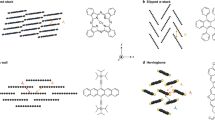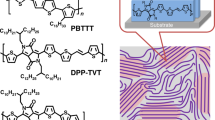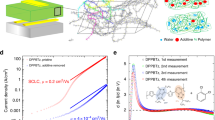Abstract
Conjugated polymers enable the production of flexible semiconductor devices that can be processed from solution at low temperatures. Over the past 25 years, device performance has improved greatly as a wide variety of molecular structures have been studied1. However, one major limitation has not been overcome; transport properties in polymer films are still limited by pervasive conformational and energetic disorder2,3,4,5. This not only limits the rational design of materials with higher performance, but also prevents the study of physical phenomena associated with an extended π-electron delocalization along the polymer backbone. Here we report a comparative transport study of several high-mobility conjugated polymers by field-effect-modulated Seebeck, transistor and sub-bandgap optical absorption measurements. We show that in several of these polymers, most notably in a recently reported, indacenodithiophene-based donor–acceptor copolymer with a near-amorphous microstructure6, the charge transport properties approach intrinsic disorder-free limits at which all molecular sites are thermally accessible. Molecular dynamics simulations identify the origin of this long sought-after regime as a planar, torsion-free backbone conformation that is surprisingly resilient to side-chain disorder. Our results provide molecular-design guidelines for ‘disorder-free’ conjugated polymers.
This is a preview of subscription content, access via your institution
Access options
Subscribe to this journal
Receive 51 print issues and online access
$199.00 per year
only $3.90 per issue
Buy this article
- Purchase on Springer Link
- Instant access to full article PDF
Prices may be subject to local taxes which are calculated during checkout




Similar content being viewed by others
References
Bruetting, W. Physics of Organic Semiconductors (Wiley-VCH, 2005)
Bässler, H. Localized states and electronic transport in single component organic solids with diagonal disorder. Phys. Stat. Solidi B 107, 9–54 (1981)
Sirringhaus, H. Device physics of solution-processed organic field-effect transistors. Adv. Mater. 17, 2411–2425 (2005)
Rivnay, J. et al. Structural origin of gap states in semicrystalline polymers and the implications for charge transport. Phys. Rev. B 83, 121306 (2011)
Noriega, R. et al. A general relationship between disorder, aggregation and charge transport in conjugated polymers. Nature Mater. 12, 1038–1044 (2013)
Zhang, W. M. et al. Indacenodithiophene semiconducting polymers for high performance air-stable transistors. J. Am. Chem. Soc. 132, 11437–11439 (2010)
Nielsen, C. B., Turbiez, M. & McCulloch, I. Recent advances in the development of semiconducting DPP-containing polymers for transistor applications. Adv. Mater. 25, 1859–1880 (2013)
Kim, N.-K. et al. Solution-processed barium salts as charge injection layers for high performance N-channel organic field-effect transistors. ACS Appl. Mater. Interfaces 6, 9614–9621 (2014)
Kim, G. et al. A thienoisoindigo-naphthalene polymer with ultrahigh mobility of 14.4 cm2/V s that substantially exceeds benchmark values for amorphous silicon semiconductors. J. Am. Chem. Soc. 136, 9477–9483 (2014)
Tseng, H.-R. et al. High-mobility field-effect transistors fabricated with macroscopic aligned semiconducting polymers. Adv. Mater. 26, 2993–2998 (2014)
Callen, H. B. Thermodynamics Ch. 17 (Wiley, 1960)
Emin, D. Seebeck effect. In Wiley Encyclopedia of Electrical and Electronics Engineering Online (ed. Webster, J. G. ) (Wiley, 2013)
Emin, D. Enhanced Seebeck coefficient from carrier-induced vibrational softening. Phys. Rev. B 59, 6205–6210 (1999)
Emin, D. Polarons (Cambridge Univ. Press, 2013)
Pernstich, K. P., Roessner, B. & Batlogg, B. Field-effect-modulated Seebeck coefficient in organic semiconductors. Nature Mater. 7, 321–325 (2008)
Kronemeijer, A. J. et al. A selenophene-based low-bandgap donor–acceptor polymer leading to fast ambipolar logic. Adv. Mater. 24, 1558–1565 (2012)
Kronemeijer, A. J. et al. Two-dimensional carrier distribution in top-gate polymer field-effect transistors: correlation between width of density of localized states and Urbach energy. Adv. Mater. 26, 728–733 (2014)
Chen, Z. et al. High performance ambipolar diketopyrrolopyrrole-thieno[3,2-b]thiophene copolymer field-effect transistors with balanced electron and hole mobilities. Adv. Mater. 24, 647–652 (2012)
Li, J. et al. A stable solution-processed polymer semiconductor with record high mobility for printed transistors. Sci. Rep. 2, 754 (2012)
Zhang, X. et al. Molecular origin of high field-effect mobility in an indacenodithiophene–benzothiadiazole copolymer. Nature Commun. 4, 2238 (2013)
Sirringhaus, H. Organic field-effect transistors — the path beyond amorphous silicon. Adv. Mater. 26, 1319–1335 (2014)
Brondijk, J. J. et al. Two-dimensional charge transport in disordered organic semiconductors. Phys. Rev. Lett. 109, 056601 (2012)
Venkateshvaran, D., Kronemeijer, A. J., Moriarty, J., Emin, D. & Sirringhaus, H. Field-effect modulated Seebeck coefficient measurements in an organic polymer using a microfabricated on-chip architecture. APL Mater. 2, 032102 (2014)
Germs, W. C., Guo, K., Janssen, R. A. J. & Kemerink, M. Unusual thermoelectric behavior indicating hopping to bandlike transition in pentacene. Phys. Rev. Lett. 109, 016601 (2012)
Overhof, H. & Beyer, W. A model for the electronic transport in hydrogenated amorphous silicon. Philos. Mag. B 43, 433–450 (1981)
DeLongchamp, D. M. et al. High carrier mobility polythiophene thin films: structure determination by experiment and theory. Adv. Mater. 19, 833–837 (2007)
von Mühlenen, A., Errien, N., Schaer, M., Bussac, M.-N. & Zuppiroli, L. Thermopower measurements on pentacene transistors. Phys. Rev. B 75, 115338 (2007)
Aselage, T. L., Emin, D., McCready, S. S. & Duncan, R. V. Large enhancement of boron carbides’ Seebeck coefficients through vibrational softening. Phys. Rev. Lett. 81, 2316–2319 (1998)
Yan, H. et al. A high-mobility electron-transporting polymer for printed transistors. Nature 457, 679–686 (2009)
Olivier, Y. et al. High-mobility hole and electron transport conjugated polymers: how structure defines function. Adv. Mater. 26, 2119–2136 (2014)
Cho, E. et al. Three-dimensional packing structure and electronic properties of biaxially oriented poly(2,5-bis(3-alkylthiophene-2-yl)thieno[3,2-b]thiophene) films. J. Am. Chem. Soc. 134, 6177–6190 (2012)
Schmidtke, J. P., Kim, J.-S., Gierschner, J., Silva, C. & Friend, R. H. Optical spectroscopy of a polyfluorene copolymer at high pressure: intra- and intermolecular interactions. Phys. Rev. Lett. 99, 167401 (2007)
Jacobson, M. A., Konstantinov, O. V., Nelson, D. K., Romanovskii, S. O. & Hatzopoulos, Z. Absorption spectra of GaN: film characterization by Urbach spectral tail and the effect of electric field. J. Cryst. Growth 230, 459–461 (2001)
Acknowledgements
We gratefully acknowledge financial support from the Engineering and Physical Sciences Research Council through a programme grant (EP/G060738/1) and the Technology Strategy Board (PORSCHED project). D.V. acknowledges financial support from the Cambridge Commonwealth Trust through a Cambridge International Scholarship. K.B. acknowledges post-doctoral fellowship support from the German Research Foundation. M.Z. acknowledges funding from NanoDTC in Cambridge. The work in Mons was supported by the European Commission/Région Wallonne (FEDER – Smartfilm RF project), the Interuniversity Attraction Pole programme of the Belgian Federal Science Policy Office (PAI 7/05), Programme d’Excellence de la Région Wallonne (OPTI2MAT project) and FNRS-FRFC. D.B. and J.C. are FNRS Research Fellows.
Author information
Authors and Affiliations
Contributions
D.V. designed and fabricated the devices and performed field-effect modulated Seebeck measurements on them. M.N. and A.J.K. optimized the fabrication of IDTBT-based organic FETs and performed transistor measurements. A.S. and M.N. performed photothermal deflection spectroscopy measurements. V.P. optimized the patterning procedure for organic devices. V.L., M.Z., Y.O., J.C. and D.B. performed quantum chemical and molecular dynamic simulations. M.Z. and M.K. acquired the high-pressure induced Raman spectra. K.B. performed measurements on DPPTTT-based devices. I.N. and I.R. performed charge accumulation spectroscopy measurements (Supplementary Information). I.M. and M.H. synthesized IDTBT. D.E. explained the Seebeck measurements on the basis of a narrow-band model. H.S. directed and coordinated the research. D.V., M.N., V.L., Y.O., J.C., D.B., D.E. and H.S. wrote the manuscript.
Corresponding author
Ethics declarations
Competing interests
The authors declare no competing financial interests.
Supplementary information
Supplementary Information
This file contains Supplementary Text and Data, Supplementary Figures 1-20, Supplementary Tables 1-2 and Supplementary references. (PDF 8680 kb)
Rights and permissions
About this article
Cite this article
Venkateshvaran, D., Nikolka, M., Sadhanala, A. et al. Approaching disorder-free transport in high-mobility conjugated polymers. Nature 515, 384–388 (2014). https://doi.org/10.1038/nature13854
Received:
Accepted:
Published:
Issue Date:
DOI: https://doi.org/10.1038/nature13854
This article is cited by
-
Nanoscale doping of polymeric semiconductors with confined electrochemical ion implantation
Nature Nanotechnology (2024)
-
Unraveling the crucial role of trace oxygen in organic semiconductors
Nature Communications (2024)
-
Numerical Simulation and Optimization of Stable Coaxial Jet Formation and Direct-Write Printing Array Nanoarchitectonics
Journal of Electronic Materials (2024)
-
Strain-enhanced electrical performance in stretchable semiconducting polymers
npj Flexible Electronics (2023)
-
Wafer-scale organic-on-III-V monolithic heterogeneous integration for active-matrix micro-LED displays
Nature Communications (2023)
Comments
By submitting a comment you agree to abide by our Terms and Community Guidelines. If you find something abusive or that does not comply with our terms or guidelines please flag it as inappropriate.



